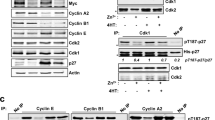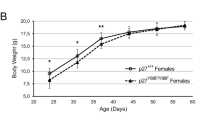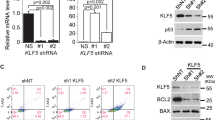Abstract
The TEL/ARG oncogene is formed by t(1;12)(q25;p13) reciprocal translocation and is associated with human leukemia. We have previously demonstrated that the expression of TEL/ARG in Ba/F3 cells results in prolonged viability and hyper-responsiveness to IL-3. To determine the molecular mechanisms, a series of mutants of TEL/ARG were generated, and each cDNA was expressed in Ba/F3 or CHO cells. The PNT domain in TEL and K317 in ARG were essential for both signaling and biological effects. The SH3 domain in ARG was required for hyper-responsiveness to IL-3, but not for prolonged viability. The opposite was true for the SH2 domain in ARG. Mutation of Y314 in TEL, a putative GRB2-binding site, led to reduced viability, and loss of hyper-responsiveness to IL-3. All biological functions were profoundly impaired with deletion of the C-terminus in ARG, despite maintaining high levels of its kinase activity. When expressed in CHO cells, wild-type TEL/ARG induced the formation of fillopodia, in a fashion dependent on the C-terminal portion and intact kinase activity. Thus, these results suggest several critical domains within TEL/ARG necessary for function, and indicate that the signaling pathways necessary for viability, growth factor hyper-responsiveness and cytoskeletal reorganization are likely to be separate.
This is a preview of subscription content, access via your institution
Access options
Subscribe to this journal
Receive 12 print issues and online access
$259.00 per year
only $21.58 per issue
Buy this article
- Purchase on Springer Link
- Instant access to full article PDF
Prices may be subject to local taxes which are calculated during checkout








Similar content being viewed by others
References
Kruh GD, King CR, Kraus MH, Popescu NC, Amsbaugh SC, McBride WO et al. A novel human gene closely related to the abl proto-oncogene. Science 1986; 234: 1545–1548.
Kruh GD, Perego R, Miki T, Aaronson SA . The complete coding sequence of arg defines the Abelson subfamily of cytoplasmic tyrosine kinases. Proc Natl Acad Sci USA 1990; 87: 5802–5806.
Perego R, Ron D, Kruh GD . Arg encodes a widely expressed 145-kDa protein-tyrosine kinase. Oncogene 1991; 6: 1899–1902.
Koleske AJ, Gifford AM, Scott ML, Nee M, Bronson RT, Miczek KA et al. Essential roles for the Abl and Arg tyrosine kinases in neurulation. Neuron 1998; 21: 1259–1272.
Cazzaniga G, Tosi S, Aloisi A, Giudici G, Daniotti M, Pioltelli P et al. The tyrosine kinase abl-related gene ARG is fused to ETV6 in an AML-M4Eo patient with a t(1;12)(q25;p13):molecular cloning of both reciprocal transcripts. Blood 1999; 94: 4370–4373.
Iijima Y, Ito T, Oikawa T, Eguchi M, Eguchi-Ishimae M, Kamada N et al. A new ETV6/TEL partner gene ARG(ABL-related gene or ABL2), identified in an AML-M3 cell line with a t(1;12)(q25;p13) translocation. Blood 2000; 95: 2126–2131.
Griesinger F, Janke A, Podleschny M, Boglander SK . Identification of an ETV6-ABL2 fusion transcript in combination with an ETV6 point mutation in a T-cell acute lymphoblastic leukaemia cell line. Br J Haematol 2002; 119: 454–458.
Iijima Y, Okuda K, Tojo A, Tri NK, Setoyama M, Sakaki Y et al. Transformation of Ba/F3 cells and Rat-1 cells by ETV6/ARG. Oncogene 2002; 21: 4374–4383.
Okuda K, Weisberg E, Gilliland DG, Griffin JD . ARG tyrosine kinase activity is inhibited by STI571. Blood 2001; 15: 2440–2448.
Van Etten RA, Jackson P, Baltimore D . The mouse type IV c-abl gene product is a nuclear protein, and activation of transforming ability is associated with cytoplasmic localization. Cell 1989; 58: 669–678.
Ren R, Ye Z-S, Baltimore D . Abl protein-tyrosine kinase selects the Crk adapter as a substrate using SH3-binding sites. Genes Dev 1994; 8: 783–795.
Kipreos ET, Wang JY . Cell cycle-regulated binding of c-Abl tyrosine kinase to DNA. Science 1992; 256: 382–385.
Van Eten R, Jackson P, Baltimore D, Sanders MC, Matsudaira PT, Janmey PA . The COOH terminus of the c-Abl tyrosine kinase conteins distinct F- and G-actin binding domains with bundling activity. J Cell Biol 1994; 124: 325–340.
Wang Y, Miller AL, Mooseker MS, Koleske AJ . The Abl-related gene (Arg) nonreceptor tyrosine kinase uses two F-actin-binding domains to bundle F-actin. Proc Natl Acad Sci USA 2001; 98: 14865–14870.
Miller AL, Wang Y, Mooseker MS, Koleske AJ . The Abl-related gene (Arg) requires its F-actin-microtubule cross-linking activity to regulate lamellipodial dynamics during fibroblast adhesion. J Cell Biol 2004; 165: 407–419.
Carroll M, Tomasson MH, Barker GF, Golub TR, Gilliland DG . The TEL/platelet-derived growth factor beta receptor (PDGF beta R) fusion in chronic myelomonocytic leukemia is a transforming protein that self-associates and activates PDGF beta R kinase-dependent signaling pathways. Proc Natl Acad Sci USA 1996; 93: 14845–14850.
Golub TR, Goga A, Barker GF, Afar DEH, McLaughlin J, Bohlander SK et al. Oligomerization of the ABL tyrosine kinase by the Ets protein TEL in human leukemia. Mol Cell Biol 1996; 16: 4107–4116.
Schwaller J, Frantsve J, Aster J, Williams IR, Tomasson MH, Ross TS et al. Transformation of hematopoietic cell lines to growth-factor independence and induction of a fatal myelo- and lymphoproliferative disease in mice by retrovirally transduced TEL/JAK2 fusion genes. EMBO J 1998; 17: 5321–5333.
Liu Q, Schwaller J, Kutok J, Cain D, Aster JC, Williams IR et al. Signal transduction and transforming properties of the TEL-TRKC fusions associated with t(12;15)(p13;q25) in congenital fibrosarcoma and acute myelogenous leukemia. EMBO J 2000; 19: 1827–1838.
Pendergast AM, Quillian LA, Cripe LD, Bassing CH, Dai Z, Li N et al. BCR-ABL induced oncogenesis is mediated by derect interaction with the AH2 domain of the GRB2 adaptor protien. Cell 1993; 75: 175–185.
Palacios R, Steinmetz M . IL-3-dependent mouse clones that express B-220 surface antigen, contain Ig genes in germ-line configuration, and generate B lymphocytes in vivo. Cell 1985; 41: 727–734.
Klucher KM, Lopez DV, Daley GQ . Secondary mutation maintains the transformed state in BaF3 cells with inducible BCR/ABL expression. Blood 1998; 91: 3927–3934.
Okuda K, Sato Y, Sonoda Y, Griffin JD . The TEL/ARG leukemia oncogene promotes viability and hyper-responsiveness to hematopoietic growth factors. Int J Hematol 2004; 79: 138–146.
Okuda K, Golub TR, Gilliland DG, Griffin JD . P210BCR/ABL, p190BCR/ABL, and TEL/ABL activate similar signal transduction pathways in hematopoietic cell lines. Oncogene 1996; 13: 1147–1152.
Oda A, Wada I, Miura K, Okawa K, Kadoya T, Kato T et al. CrkL directs ASAP1 to peripheral focal adhesions. J Biol Chem 2003; 278: 6456–6460.
Bazzoni G, Carlesso N, Griffin JD, Hemler ME . Bcr/Abl expression stimulates integrin function in hematopoietic cell lines. J Clin Invest 1996; 98: 521–528.
Salgia R, Li JL, Ewaniuk DS, Pear W, Pisick E, Burky SA et al. BCR/ABL induces multiple abnormalities of cytoskeletal function. J Clin Invest 1997; 100: 46–57.
Golub TR, Barker G, Lovett M, Gilliland DG . Fusion of platelet-derived growth factor beta to a novel ets-like gene in chronic myelomonocytic leukemia with t(5;12) chromosomal translocation. Cell 1994; 77: 307–316.
Wang B, Kruh GD . Subcellular localization of the Arg protein tyrosine kinase. Oncogene 1996; 13: 193–197.
Ben-Neriah Y, Daley GQ, Mes-Masson AM, Witte ON, Baltimore D . The chronic myelogenous leukemia-specific P210 protein is the product of the bcr/abl hybrid gene. Science 1986; 233: 212–214.
Papadopoulos P, Ridge SA, Boucher DA, Stocking C, Wiedemann LM . The novel activation of ABL by fusion to an ets-related gene, TEL. Cancer Res 1995; 55: 34–38.
Okuda K, D'Andrea A, Van Etten RA, Griffin JD . The c-terminus of c-Abl is required for proliferation and viability signaling in a c-Abl/erythropoietin receptor fusion protein. Blood 1998; 92: 3848–3856.
Skolnik EY, Lee CH, Batzer A, Vicentini LM, Zhou M, Daly R et al. The SH2/SH3 domain-containing protein GRB2 interacts with tyrosine-phosphorylated IRS1 and Shc: implications for insulin control of ras signalling. EMBO J 1993; 12: 1929–1936.
Million RP, Van Etten RA . The Grb2 binding site is required for the induction of chronic myeloid leukemia-like disease in mice by the Bcr/Abl tyrosine kinase. Blood 2000; 96: 664–670.
Sattler M, Mohi MG, Pride YB, Quinnan LR, Malouf NA, Podar K et al. Critical role for Gab2 in transformation by BCR/ABL. Cancer Cell 2002; 1: 479–492.
Van Etten RA, Debnath J, Zhow H, Casasnovas JM . Introduction of a loss-of function point mutation from the SH3 region of the Caenorhabditis elegans sem-5 gene activates the transforming ability of c-abl in vivo and abolishes binding of proline-rich ligands in vitro. Oncogene 1995; 10: 1977–1988.
McWhirter JR, Wang JY . An actin-binding function contributes to transformation by the Bcr-Abl oncoprotein of Philadelphia chromosome-positive human leukemias. EMBO J 1993; 12: 1533–1546.
Salgia R, Brunkhorst B, Pisick E, Li JL, Lo SH, Chen LB et al. Increased tyrosine phosphorylation of focal adhesion proteins in myeloid cell lines expressing p210BCR/ABL. Oncogene 1995; 11: 1149–1155.
Heisterkamp N, Voncken JW, Senadheera D, Gonzalez-Gomez I, Reichert A, Haataja L et al. Reduced oncogenicity of p190Bcr/Abl F-actin-binding domain mutants. Blood 2000; 96: 2226–2232.
Wertheim JA, Perera SA, Hammer DA, Ren R, Boettiger D, Pear WS . Localization of BCR-ABL to F-actin regulates cell adhesion but does not attenuate CML development. Blood 2003; 102: 2220–2228.
Acknowledgements
This work was supported in part by Grants-in-Aid for Scientific Research from the Japan Society for the Promotion of Science (AO, KO), the Research Fund of the Mitsubishi Pharma Research Foundation (KO), the Sagawa Foundation for Promotion of Cancer Research (KO), and the Smoking Research Foundation (AO).
Author information
Authors and Affiliations
Corresponding author
Rights and permissions
About this article
Cite this article
Okuda, K., Oda, A., Sato, Y. et al. Signal transduction and cellular functions of the TEL/ARG oncoprotein. Leukemia 19, 603–610 (2005). https://doi.org/10.1038/sj.leu.2403668
Received:
Accepted:
Published:
Issue Date:
DOI: https://doi.org/10.1038/sj.leu.2403668
Keywords
This article is cited by
-
Constitutively active ABL family kinases, TEL/ABL and TEL/ARG, harbor distinct leukemogenic activities in vivo
Leukemia (2017)
-
Arg
AfCS-Nature Molecule Pages (2006)



